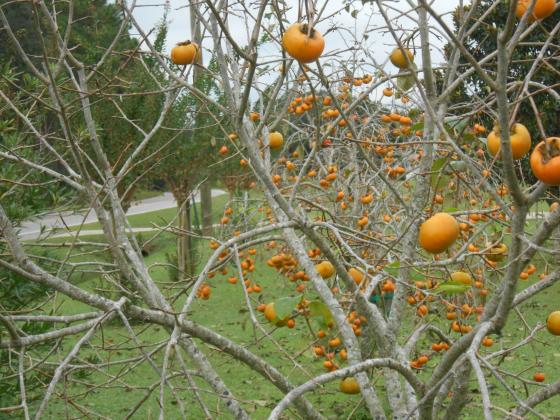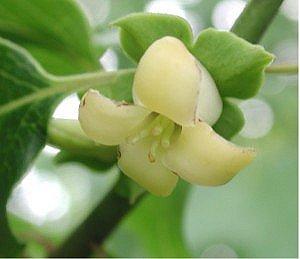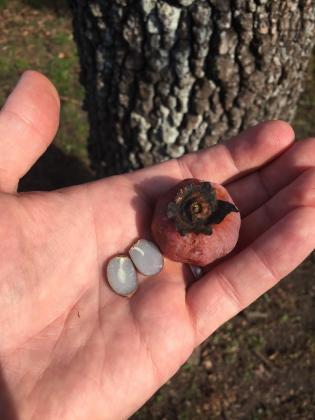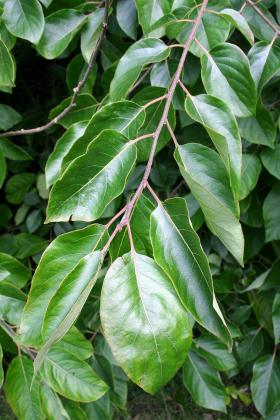Diospyros - weather predicting seeds
Backyard Horticulture
Diospyros spp. refers to several species of the persimmon tree. Some have been in North America and cultivated by Native Americans since prehistoric times. In their article “Persimmons” Texas A&M University, aggie-horticulture.tamu.edu, said, “Persimmon trees are small, easy to grow, and adapted to most of Texas. The tree, its leaves, and its fruit don’t have to be sprayed because they have no serious insect or disease problems. In the fall, when few fruit crops are ripe, the persimmon produces fruit that is attractive and delicious. Persimmons are rich in vitamin A and have more vitamin C than citrus fruit. They are considered a delicacy in the Orient. The wood, which is very hard, is prized by woodworkers and is used to make golf clubs. Mature trees can reach 40-feet high; some remain as shrubs less than 10-feet tall.”
Leaves are alternate, 4 to 6-inches long, thick, dark green and shiny. Depending on the species, they may not change color in the fall. Flowers, various shades of beige, are pollinated by insects and the wind. The bark is dark brown to dark gray with a vertical brick-like pattern. Persimmon is in the Ebenaceae, ebony family, known for its high quality wood. There are superstitions about burning persimmon wood in the house. It crackles and pops, making a lot of noise. Some say this is unlucky. Folklore says that if you manage to put a piece of the wood in someone’s fireplace, he will soon move away.
The name Diospyros is from ancient Greek meaning “divine fruit”. The word persimmon is from a Native American word meaning “a dry fruit.” Whoever named it may have tasted it before it ripened and lost its astringency, that would have puckered and dried their mouth. The persimmon fruit is a berry, the largest in North America. Depending on the species, ripe fruit ranges from yellow to deep purple and may be on the tree after the leaves have fallen. Inside are one to eight seeds.
The seeds have been used to make buttons, jewelry, etc. They were strung and worn as a necklace to ward off disease. It’s said the split seeds can forecast the weather. The Farmers’ Almanac’s most recent persimmon forecast at farmersalmanac.com was “The Persimmon Lady’s 2018-19 Winter Forecast.” “According to folklore, if you crack open a persimmon seed from a ripe fruit and the shape inside (called a cotyledon) looks like a fork, winter will be mild; if you see a spoon, there will be a lot of snow, and if there is a knife, winter will be bitingly cold and ‘cut like
Courtesy photo by Jean-Pol GRANDMONT
Persimmon trees don’t have to be sprayed because they have no serious insect nor disease problems. A tea is made from the dried leaves.
a knife.’” For the forecast, 26 fruits were used for a total of 100 seeds. The Persimmon Lady reported, “Out of this total, I only found two forks. The remaining seeds were all spoons. No knives. This will be a winter for the record books in central North Carolina!” I don’t know what Texas persimmons had to say.
Plants for a Future, PFAF, pfaf.org, listed several ways to eat persimmons. “Fruit - raw, cooked or dried and used in breads, cakes, pies, puddings etc. … The fruit has an exquisitely rich flavor when it is fully ripe (and almost at the point of going bad) but it is very harsh and astringent before then ... The fruit can also be dried and used in bread, cakes etc. ... Molasses can be made from the fruit pulp. An oil obtained from the seeds is said to taste like peanut oil. A tea is made from the dried leaves… The roasted seed is used as a coffee substitute.” Jams, jellies, fermented beverages, etc. are also made. People with digestive issues who eat a large quantities of persimmons may be at risk for developing a bezoar, an intestinal blockage. Persimmon is in the Food and Drug Administration Poisonous Plant Database at fda.gov.
Various parts of the persimmon tree were used medicinally to treat earache, falling hair, intestinal worms, hiccups, etc. PFAF said, “A decoction of the boiled fruit was used to treat bloody stools. (This probably referred to the unripe fruit, which is very astringent). The leaves are rich in vitamin C and are used as an antiscorbutic. A decoction of the inner-bark is highly astringent. It has been used as a mouth rinse in the treatment of thrush and sore throats. Used externally as a wash for warts or cancers.” Antiscorbutic is something that prevents scurvy. Thrush is an infection that causes white patches in the mouth, most often in children and infants.
Deborah Richardson is a freelance reporter for The Examiner with a fondness for flora in its natural setting.




